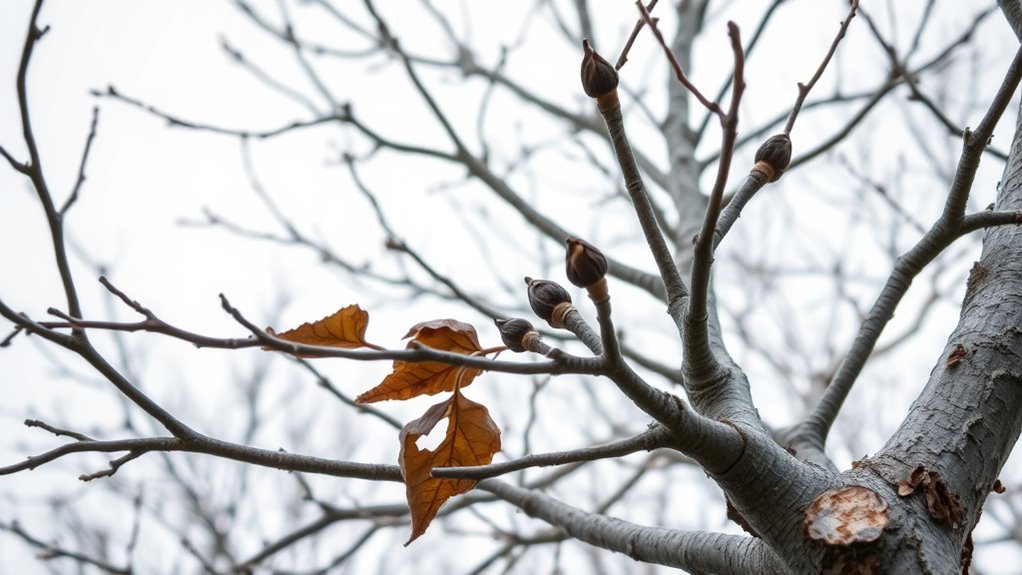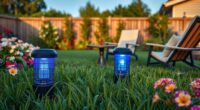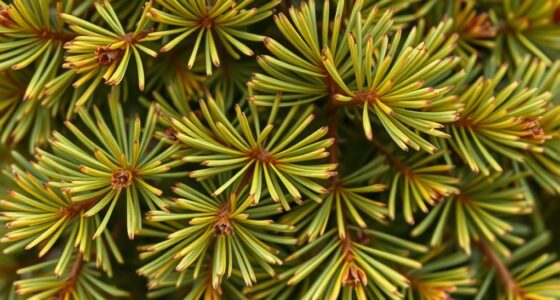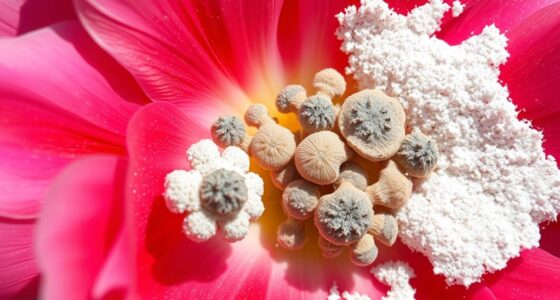If your dogwood isn’t leafing out, it could be due to insufficient chill hours in winter, which are essential for breaking dormancy and encouraging growth, or pests like borers damaging the trunk and roots. Diseases such as powdery mildew or cankers can also weaken the tree, preventing healthy leaf development. Environmental stresses or improper care might be factors too. To find out more about diagnosing and fixing these issues, continue exploring what might be impacting your tree’s health.
Key Takeaways
- Insufficient winter chill hours can delay or prevent dogwood leafing out and flowering.
- Signs of borers include holes, frass, and tunnel activity in the trunk or branches.
- Disease symptoms such as leaf spots, powdery mildew, or cankers can hinder leaf development.
- Proper pruning, pest management, and environmental monitoring help identify and address leafing issues.
- Ensuring adequate soil moisture, correct pruning timing, and winter chill accumulation promotes healthy leafing.
Understanding Chill Hours and Their Impact on Dogwoods
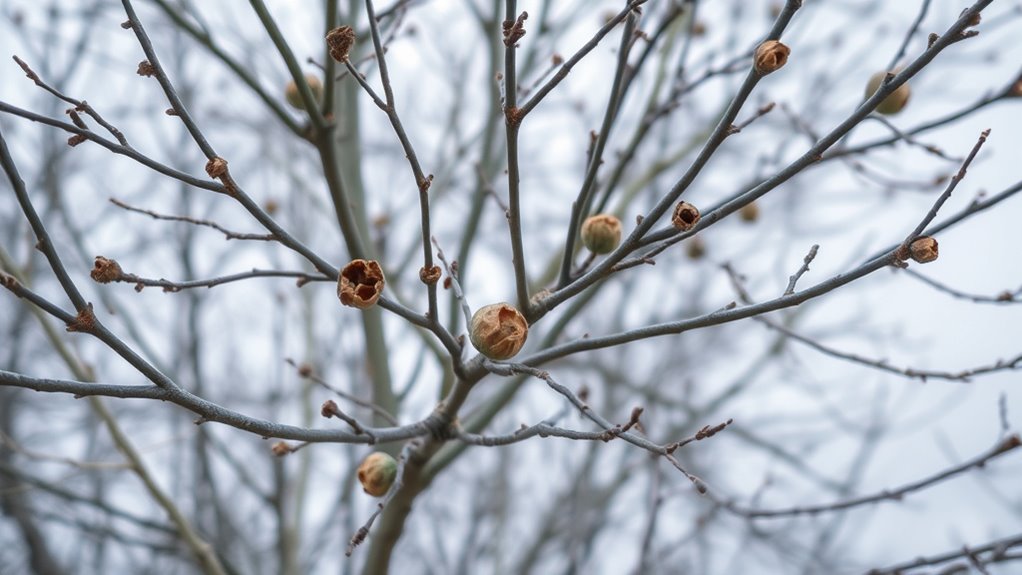
Chill hours play a crucial role in the health and flowering of dogwood trees, especially in regions with variable winter temperatures. These are the hours of cold weather needed to break dormancy and trigger spring growth. Without enough chill hours, your dogwood may struggle to emerge from its dormant period, resulting in delayed or absent leafing. Understanding how chill hours accumulate during winter helps you predict flowering and overall health. If your area experiences mild winters, your dogwood might not receive sufficient chill hours, which can cause problems in leafing out normally. Providing the right winter conditions ensures the tree completes its dormant period properly. Keep track of local chill hour totals to better care for your dogwood and support its annual cycle. Additionally, proper winter conditions can influence the accumulation of chill hours necessary for optimal growth, aligning with the creative practice of observing and adapting to natural patterns. Monitoring chill hour accumulation over time can help predict flowering success in upcoming seasons.
Common Pests That Affect Leafing in Dogwood Trees

You should watch for signs of dogwood borer infestations, like unusual trunk holes or wilting leaves. Powdery mildew can also coat the leaves, making them look sickly and reducing their ability to photosynthesize. Additionally, leaf spot diseases may cause spots or blights that hinder the tree’s leafing process. Maintaining healthy trees through proper care can help support disease resistance and overall vitality. Using appropriate air purification technology can improve air quality around your garden, reducing stress on the tree and helping prevent disease spread. Regular pruning and monitoring can further prevent pest infestations that compromise leafing.
Dogwood Borer Infestation Signs
Have you noticed tiny holes or tunnels at the base of your dogwood tree’s bark? These are common signs of a dogwood borer infestation. You might also see frass, a fine sawdust-like material, near the entry points. The borer larvae tunnel beneath the bark, disrupting the flow of nutrients and water, which can weaken the tree. As the infestation progresses, the bark may develop rough or sunken textures, and you might notice abnormal changes in the tree’s bark textures overall. Additionally, look for unusual patterns in the dogwood fruit, such as poor development or premature dropping, which can also signal stress caused by borers. Early detection is key to preventing extensive damage and helping your tree recover.
Powdery Mildew Impact
Powdery mildew is a common fungal disease that can substantially affect a dogwood tree’s ability to produce healthy leaves. When your tree is infected, you’ll notice a white, powdery coating on leaf surfaces, often starting on new growth. This disease causes leaf distortion, making leaves curl, twist, or become misshapen, which hampers photosynthesis and overall vigor. As the infection spreads, it weakens the tree’s ability to leaf out properly in spring. While powdery mildew rarely kills a dogwood outright, it stresses the tree and can delay leaf emergence. To manage it, prune affected areas, improve air circulation, and apply fungicides if needed. Addressing powdery mildew early helps ensure your dogwood produces healthy, lush foliage. Understanding disease prevention techniques can further protect your tree from future infections, including selecting resistant varieties and maintaining proper cultural practices. Proper monitoring for early signs of infection can also help prevent severe outbreaks.
Leaf Spot Diseases
Leaf spot diseases are among the most common pests that can hinder a dogwood tree’s ability to leaf out properly. These fungi thrive in poorly drained soil, so improving soil drainage can help prevent infection. Proper root pruning encourages healthy roots, making the tree more resistant to disease. To manage leaf spot diseases, consider these steps:
- Remove and discard infected leaves to reduce spores.
- Ensure good air circulation around the tree.
- Avoid overhead watering to keep foliage dry.
- Apply fungicides if infections persist.
- Recognizing the importance of holistic care models can help address underlying stress factors that compromise tree health.
Healthy soil drainage and careful root pruning are crucial in reducing the severity of leaf spot diseases. Keeping your dogwood’s roots healthy minimizes stress, helping it leaf out more vigorously and resist future infections.
Recognizing Signs of Disease in Dogwood Trees
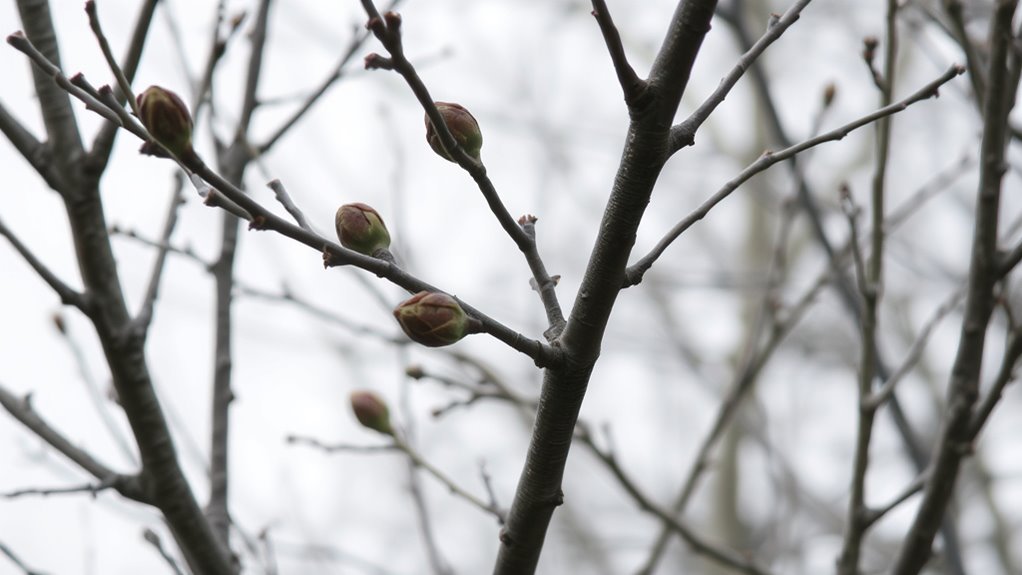
When your dogwood tree fails to leaf out as expected, it’s important to look for other signs of disease that could be affecting its health. Check the root zone for signs of poor root health, such as discoloration, rotting, or a foul smell. Soil conditions also play a vital role; overly compacted, poorly drained, or nutrient-deficient soil can weaken roots and hinder growth. Look for wilting, dieback, or unusual leaf color, which may indicate disease. Fungal infections often cause bark lesions or cankers, while abnormal growth patterns or discolored wood may also signal trouble. By examining these symptoms early, you can better diagnose issues and take steps to improve your dogwood’s health before it’s too late. Additionally, environmental factors like chill hours can influence flowering and leafing, so consider recent weather patterns in your assessment. Monitoring for disease symptoms early can help prevent more serious damage and promote recovery, especially since subconscious influence during sleep can impact your ability to recognize subtle signs of plant stress.
Seasonal Factors Influencing Dogwood Growth Cycles
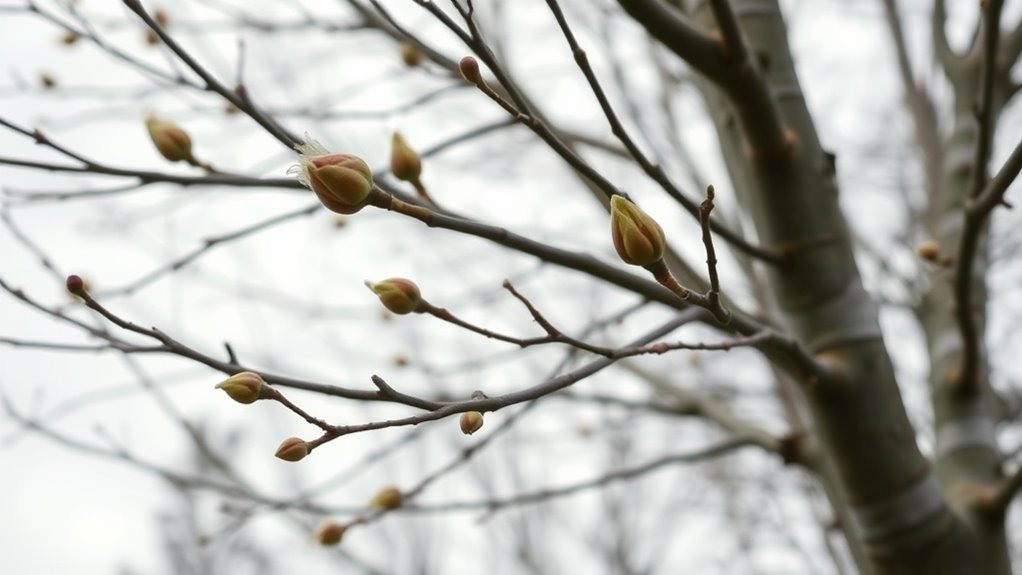
Seasonal changes profoundly influence the growth cycles of dogwood trees, dictating when they bud, flower, and leaf out. Understanding these factors helps you determine why your tree might be delayed or not leafing out as expected. Proper hybrid bike maintenance and awareness of environmental conditions can also impact overall plant health. 1. Temperature fluctuations: Sudden cold snaps can delay bud development. 2. Chill hours: Insufficient winter Chill hours can prevent proper blooming. 3. Tree pruning: Pruning at the wrong time can hinder growth; late winter or early spring is best. 4. Fertilization timing: Applying fertilizer too early or too late disrupts growth cycles. Additionally, self watering plant pots can help maintain consistent soil moisture, supporting healthy development during unpredictable weather. Monitoring these seasonal factors helps you support healthy dogwood development and ensures your tree leafs out at the right time.
Diagnosing Damage From Borers and Other Insects
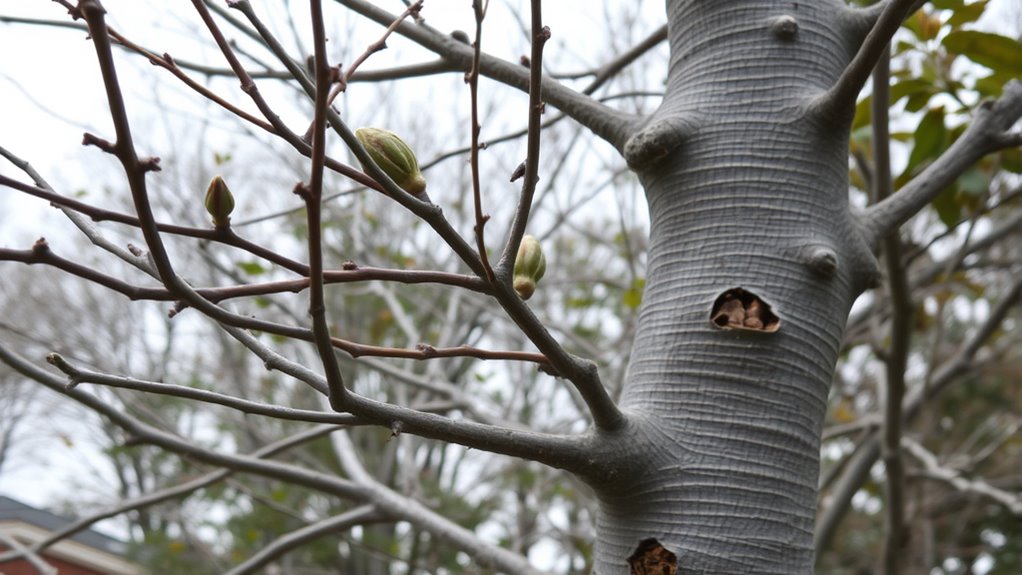
To diagnose insect damage, start by looking for signs like exit holes, frass, or missing bark that indicate borers are active. Then, carefully inspect the interior of your tree for tunneling or decay. Don’t forget to check for other pests, such as scale or aphids, which can also stress your dogwood. Monitoring for pest symptoms can help identify underlying issues early. Advances in AI’s impact on pest detection are increasingly aiding homeowners and arborists in early identification and management of such problems. Additionally, using preventive care strategies like proper watering and mulching can reduce stress that makes trees more vulnerable to pests.
Identifying Borer Symptoms
Borer damage often manifests as subtle signs that can be easy to overlook until the problem worsens. Look for small holes in the bark, sawdust-like frass around the base, or uneven growth. You might notice leaves yellowing or wilting despite proper fertilizer application. To spot borers early, check for any cracks or splits in the bark, especially near the trunk or branches. Use pruning techniques to remove and discard infested wood, preventing spread. Also, examine the tree’s overall health; stressed trees are more vulnerable. Keep an eye on these symptoms, as ignoring them can lead to severe damage. Regular inspections and prompt action are key to managing borer infestations effectively. Incorporating preventative measures such as maintaining proper watering and avoiding mechanical injuries can help reduce the risk of infestation. Additionally, understanding common goal tracking pitfalls can help you stay focused on your tree care objectives and improve your overall management strategy.
Inspecting Tree Internally
Inspecting a tree internally is essential for accurately diagnosing damage caused by borers and other insects. To do this, start by carefully removing loose bark and inspecting the inner wood and cambium layer for tunnels, frass, or exit holes. Use proper pruning techniques to cut back affected branches, which helps reveal internal damage without causing unnecessary harm. While inspecting, consider soil amendments that improve overall tree health, making it more resistant to pests. Be gentle when probing the trunk with a screwdriver or knife to identify soft spots or tunnels. Remember, internal damage often isn’t visible from the outside, so a thorough internal check helps you determine if borers are the cause of poor leafing out or other decline.
Recognizing Other Pests
Recognizing damage caused by borers and other insects requires careful observation of symptoms and signs on the tree. Look for holes in the bark, sawdust-like frass, or sections of dying branches. Check the soil moisture around the tree, as stressed trees often attract pests. Examine the root zone for signs of poor root health, such as wilting or uneven growth.
To identify pest issues, consider these key points:
- Small entry holes in bark or trunk
- Exit holes with frass buildup
- Dead or dying branches with minimal leafing
- Unusual soil moisture levels affecting root vitality
Early detection helps manage infestations before they cause severe damage to your dogwood’s overall health.
Cultural Practices to Promote Healthy Leafing
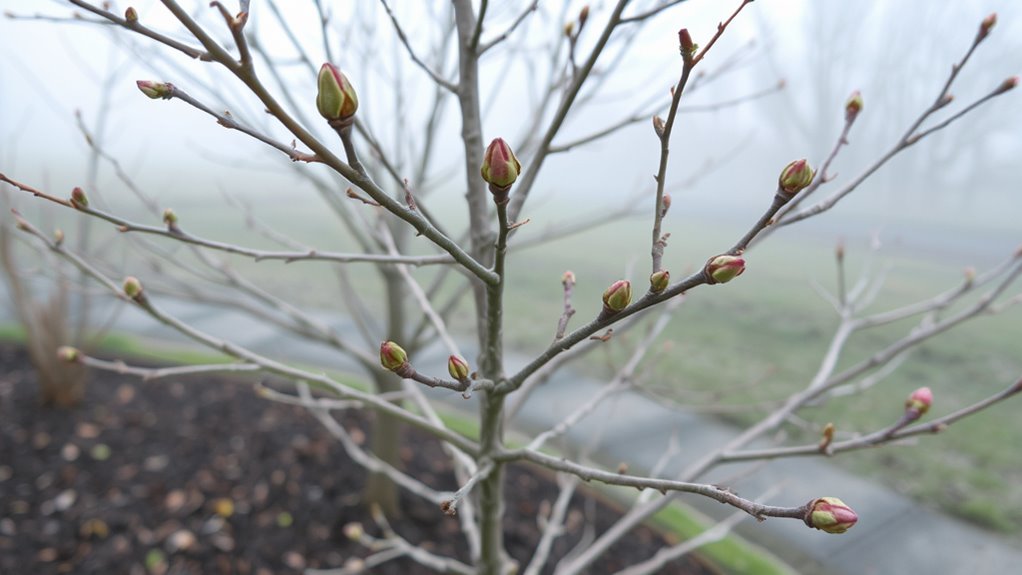
To encourage a healthy leafing process in your dogwood tree, proper cultural practices are essential. Focus on fertilization techniques by applying a balanced, slow-release fertilizer in early spring to support growth. Avoid over-fertilizing, which can lead to weak, lush foliage susceptible to pests and diseases. Follow a consistent pruning schedule, removing dead or diseased branches to improve airflow and light penetration. Prune during late winter or early spring before new growth begins, but avoid heavy pruning that stresses the tree. Keep the soil moist but not waterlogged, especially during dry spells. Regularly inspect for signs of pests or disease, and maintain overall tree health. These practices bolster your dogwood’s resilience, encouraging robust leafing and vibrant growth.
When to Seek Professional Help for Your Dogwood
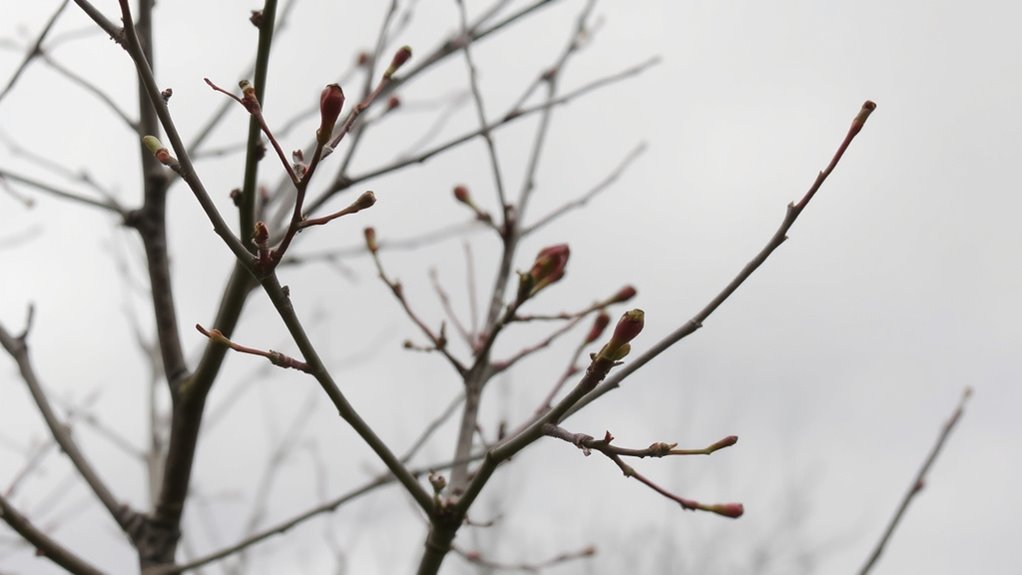
If your dogwood tree shows persistent issues despite proper care, it’s time to contemplate professional help. You should consult an arborist or tree specialist if you notice:
- Signs of root rot, such as wilting or a foul smell around the base.
- Changes in soil acidity affecting tree health, like poor leafing or discoloration.
- No leafing out after several seasons despite correct cultural practices.
- Unexplained dieback or bark abnormalities that could indicate disease or pest problems.
A professional can assess soil conditions, test for root rot, and recommend treatments or soil amendments. Addressing issues early prevents long-term damage and ensures your dogwood regains health.
Frequently Asked Questions
Can Soil Conditions Prevent Dogwood Leafing Out?
Yes, soil conditions can prevent your dogwood from leafing out. If the soil is too dry or overly waterlogged, it affects root health and nutrient uptake. Additionally, a pH imbalance can hinder proper growth by making essential nutrients unavailable. Confirm your soil has proper moisture levels and a balanced pH to support healthy leafing. Regular testing and adjusting soil conditions can help your dogwood thrive again.
Are Artificial Fertilizers Effective for Encouraging Dogwood Leaf Growth?
Ever wonder if artificial nutrients truly boost your dogwood’s leaf growth? While fertilizer effectiveness varies, relying solely on artificial fertilizers might not solve underlying issues like pests or disease. They can provide quick nutrients, but healthy growth depends on balanced soil conditions and proper care. Don’t overlook natural soil health—sometimes, nature’s solutions outperform synthetic options, making your tree stronger and more resilient in the long run.
How Long Should I Wait Before Replacing a Non-Leafing Dogwood?
You should wait until late spring, around 4 to 6 weeks after the usual leaf-out time, before replacing your dogwood. If your tree is mature and still hasn’t leafed out by then, it’s likely not going to recover. Young trees may need more patience, but if there’s no sign of growth, replacing it might be the best option. Always consider the specific spring timing for your area and your tree’s maturity.
Do Dogwoods Leaf Out Differently in Shaded vs. Sunny Locations?
You’ll notice that shade effects and sun exposure influence how dogwoods leaf out. In shaded areas, they tend to leaf out later or more sparsely because they receive less direct sunlight, which slows growth. On the other hand, sun-exposed dogwoods usually leaf out earlier and more vigorously, benefiting from ample light. So, your tree’s leafing pattern depends greatly on its placement, with sun exposure promoting quicker, fuller leafing compared to shaded spots.
Can Pruning Too Early Affect Leafing in Spring?
Pruning timing definitely impacts spring leafing. If you prune too early, you might remove the buds that would have opened into leaves or flowers, causing delayed or sparse spring leafing. To encourage healthy growth, prune at the right time—after the worst frosts, but before new growth begins. Proper timing helps guarantee your dogwood develops strong, vibrant leaves in spring, avoiding delays caused by premature pruning.
Conclusion
If your dogwood isn’t leafing out, it’s like a silent plea from nature—a mystery waiting to be unraveled. By understanding chill hours, inspecting for pests, and recognizing disease signs, you hold the key to nurturing its revival. Remember, patience and observation are your best tools; sometimes, nature’s story unfolds slowly, whispering truths only the attentive can hear. Trust your instincts, and don’t hesitate to seek help—your dogwood’s comeback may be just a decision away.
